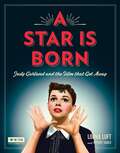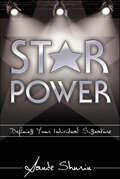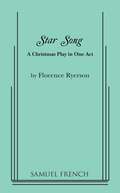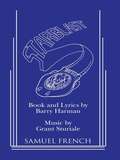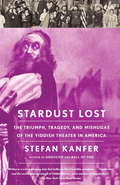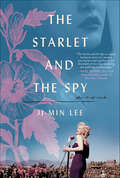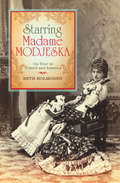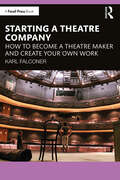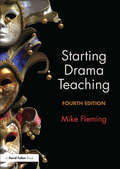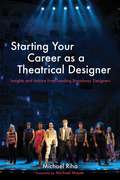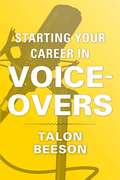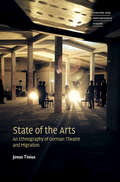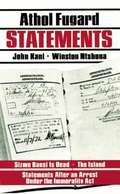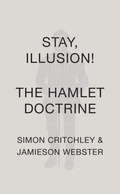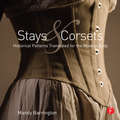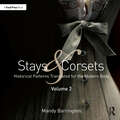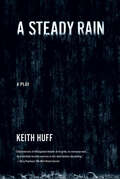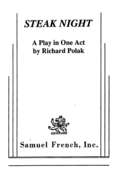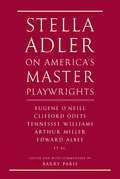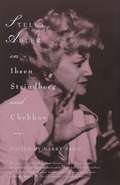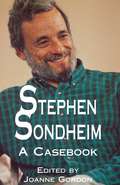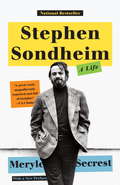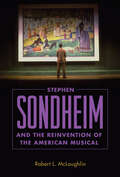- Table View
- List View
A Star Is Born: Judy Garland and the Film that Got Away (Turner Classic Movies)
by Lorna Luft Jeffrey VanceNew York Times bestselling author and daughter of Judy Garland tells the story of A Star Is Born -- at once the crowning achievement and greatest disappointment in her mother's legendary career. This is a vivid account of a film classic's production, loss, and reclamation.A Star Is Born -- the classic Hollywood tale about a young talent rising to superstardom, and the downfall of her mentor/lover along the way -- has never gone out of style. It has seen five film adaptations, but none compares to the 1954 version starring Judy Garland in her greatest role. But while it was the crowning performance of the legendary entertainer's career, the production turned into one of the most talked about in movie history.The story, which depicts the dark side of fame, addiction, loss, and suicide, paralleled Garland's own tumultuous life in many ways. While hitting alarmingly close to home for the fragile star, it ultimately led to a superlative performance -- one that was nominated for an Academy Award, but lost in one of the biggest upsets in Oscar history. Running far too long for the studio's tastes, Warner Bros. notoriously slashed extensive amounts of footage from the finished print, leaving A Star is Born in tatters and breaking the heart of both the film's star and director George Cukor.Today, with a director's cut reconstructed from previously lost scenes and audio, the 1954 A Star is Born has taken its deserved place among the most critically acclaimed movies of all time, and continues to inspire each new generation that discovers it. Now, Lorna Luft, daughter of Judy Garland and the film's producer, Sid Luft, tells the story of the production, and of her mother's fight to save her career, as only she could. Teaming with film historian Jeffrey Vance, A Star Is Born is a vivid and refreshingly candid account of the crafting, loss, and restoration of a movie classic, complemented by a trove of images from the family collection taken both on and off the set. The book also includes essays on the other screen adaptations of A Star Is Born, to round out a complete history of a story that has remained a Hollywood favorite for close to a century.
Star Power: Defining Your Individual Signature
by Sande ShurinSTAR POWER! establishes a new wave of Acting. It speaks to current and relevant issues that creative Actors are grappling with: How do I “BE” authentic and respond from my truth and still BE the character? How do I respond spontaneously and still fulfill the Director's vision? How do I bring my rich inner imaginative world out to be visible in the material world? What is the the“IT” factor? It’s STAR POWER! STAR POWER! engages the Actor in new possibilities, helping them develop their Authentic Self and define their Individual Signature. As an acting coach, it is Ms. Shurin’s job to transform good actors into “brilliant” ones. This is a book about Ms Shurin’s new discoveries on how to create an Individual Signature for the actor. The combination of “Individual Signature”, becoming that “brilliant actor” and having the the “commitment” to become a star is the missing link. Actors of all levels of experience will find interesting interviews from industry professionals and fellow Actors confirming these principles. STAR POWER! works. It is the future of acting. Ms. Shurin has recently found that these same principles benefit anyone in any profession: attorneys, doctors, salespeople, parents, teachers, students, politicians and more. She hopes these life-altering principles will be used for the betterment of humanity.
Star Song
by Florence RyersonChristmas Play / 4m, 5f / The scene is an inn on the way to Bethlehem on the night of Christ's birth. The inn's occupants are too busy with their squabbles and personal worries to sense the great, holy event occurring in a stable nearby. Only a slave and a little lame girl are prepared for this momentous occasion. It is a very dramatic, touching play. A good opportunity for singing clubs or choirs, but the music may be minimal if desired.
Starblast
by Barry HarmanAll Groups / Musical / 3 m., 2 f. minimum (can be done with up to 25 m. and f.) / This colorful musical demonstrates the importance of imagination in a world overwhelmed by technology. A young star voyager named P T III crashes his spacecraft on a bleak and forbidding world ruled by the dreaded and unseen Starblasters. He has 60 minutes to depart or he must face the Starblasters in mortal combat. His desperate search for help leads him to a nervous space dragon, a floating Moon Valley girl, two vaudevillian computer robots, some teen space greasers and finally, the awesome Mother Space. Each offers him advice but no help. Time is up and P T III faces the Starblasters. He is victorious at first, but the Starblasters re generate over and over until Peter Trenton III wakes up clutching his new Starblasters video game. Would be astronaut Peter stares out at the stars and knows it is fun to dream.
Stardust Lost: The Triumph, Tragedy, and Mishugas of the Yiddish Theater in America
by Stefan KanferInStardust Lost, Stefan Kanfer brings the colorful Yiddish stage roaring back to life. Born of ancient traditions stretching back to the drama of the Old Testament, the Yiddish theater was a vibrant part of the immigrant experience. Kanfer invokes the energy, belief, and purechutzpahit took to establish and run the thriving, influential theaters. He reveals the nightly drama and comedy that played out behind the scenes as well as onstage, and introduces all the players--actors, divas, playwrights, directors, and producers--who made it possible. A richly evocative chronicle of its brief but dazzling existence in America, this is both an elegy for and a tribute to Yiddish theater--lost, but not forgotten.
The Starlet and the Spy: A Novel
by Ji-min Lee“This story of the unlikely meeting of two vulnerable women is a beautifully woven page turner. The battle-weary woman and the pin-up girl who meet, connect, separate: each changed by the brief union.” --Heather Morris, author of the #1 New York Times bestseller The Tattooist of AuschwitzA dazzling work of historical fiction, based on true events, about two women who seem the most unlikely to ever meet: Alice, a Korean war survivor and translator for the American forces in Seoul and Marilyn Monroe, who is visiting Korea on a four-day USO tour.February 1954. Although the Korean War armistice was signed a year ago, most citizens of Seoul still battle to return to some semblance of normalcy. Conditions are dismal. Children beg for food, and orphanages are teeming. Alice J. Kim, a Korean translator and typist for the American forces still sanctioned in the city, yearns for the life she used to live before her country was torn apart.Then Alice’s boss makes an announcement—the American movie star Marilyn Monroe will be visiting Korea on a four-day USO tour, and Alice has been chosen as her translator. Though intrigued, Alice has few expectations of the job—what could she and a beautiful actress at the peak of her fame possibly have to talk about? Yet the Marilyn she meets, while just as dazzling and sensual as Alice expected, is also surprisingly approachable.As Marilyn’s visit unfolds, Alice is forced into a reckoning with her own painful past. Moving and mesmerizing, The Starlet and the Spy is a beautiful portrayal of unexpected kinship between two very different women, and of the surprising connections that can change, or even save, a life.
Starring Madame Modjeska: On Tour in Poland and America
by Beth HolmgrenThe &“important . . . meticulously researched&” prize-winning biography of the pre-eminent Polish star of the nineteenth century global stage (CosmopolinReview.com). In reintroducing &“a little-remembered actress to a new American audience&” biographer Beth Holgram delivers a revelatory portrait of Helena Modjeska—from unparalleled European success to her reign as the most acclaimed, and most recognized female celebrity in the late nineteenth-century United States. In 1876, Poland&’s leading actress, Helena Modrzejewska, accompanied by her husband, the self-stylized Count Bozente, emigrated to southern California to give up her career and establish a utopian commune. In light of its failings, it hardly fulfilled the real dreams of Madame Helena. Within a year, she changed her surname to Modjeska, and made her American debut at San Francisco&’s California Theatre. Godmother to Ethel Barrymore, and sharing the Shakespearian stage with such luminaries as Otis Skinner, Edwin Booth, and Maurice Barrymore, Helena Modjeska became the leading star in the United States, where she reigned for the next thirty years. In this &“Impressive . . . achievement,&” Holmgren traces Modjeska&’s fabulous life and career from her illegitimate birth in Krakow, to her successive reinventions of herself as a trans-continental diva, and finally to her enduring legacy (Women&’s Review of Books). All in all, Starring Madame Modjeska &“makes for great drama&” (NewPages.com).
Stars and Spies: The story of Intelligence Operations…
by Christopher Andrew Julius GreenA vastly entertaining and unique history of the interaction between spying and showbiz, from the Elizabethan age to the Cold War and beyond.'A treasure trove of human ingenuity' The TimesWritten by two experts in their fields, Stars and Spies is the first history of the extraordinary connections between the intelligence services and show business.We travel back to the golden age of theatre and intelligence in the reign of Elizabeth I. We meet the writers, actors and entertainers drawn into espionage in the Restoration, the Ancien Régime and Civil War America. And we witness the entry of spying into mainstream popular culture throughout the twentieth century and beyond - from the adventures of James Bond to the thrillers of John le Carré and long-running TV series such as The Americans.'Thoroughly entertaining' Spectator'Perfect...read as you settle into James Bond on Christmas afternoon.' Daily Telegraph
Starting a Theatre Company: How to Become a Theatre Maker and Create Your Own Work
by Karl FalconerExploring everything from company incorporation and marketing, to legal, finance and festivals, Starting a Theatre Company is the complete guide to running a low-to-no budget or student theatre company. Written by an experienced theatre practitioner and featuring on-the-ground advice, this book covers all aspects of starting a theatre company with limited resources, including how to become a company, finding talent, defining a style, roles and responsibilities, building an audience, marketing, the logistics of a production, legalities, funding, and productions at festivals and beyond. The book also includes a chapter on being a sustainable company, and how to create a mindset that will lead to positive artistic creation. Each chapter contains a list of further resources, key terms and helpful tasks designed to support the reader through all of the steps necessary to thrive as a new organisation. An eResource page contains links to a wide range of industry created templates, guidance and interviews, making it even easier for you to get up and running as simply as possible. Starting a Theatre Company targets Theatre and Performance students interested in building their own theatre companies. This book will also be invaluable to independent producers and theatre makers.
Starting Drama Teaching
by Mike FlemingWhy teach drama? How can a newcomer teach drama successfully? How do we recognize quality in drama? Starting Drama Teaching is a comprehensive guide to the teaching of drama in schools. Exploring the aims and purposes of drama, it provides an insight into the theoretical perspectives that underpin practice alongside activities, example lesson plans and approaches to planning. Written in an accessible style, the book addresses such practical issues as setting up role play, how to inject depth into group drama, working with text, teaching playwriting, as well as common problems that arise in the drama classroom and how to avoid them. ?? This fourth edition has been updated to reflect the latest educational thinking and developments in policy and includes: a new chapter on researching drama; an extra section on digital technology and drama; guidance on different approaches to drama; advice on how teachers can achieve and recognize quality work in drama; a discussion of drama concepts including applied theatre, ensemble and rehearsal approaches. Acting on the growing interest in drama both as a separate subject and as a teaching methodology, this book is full of sensible, practical advice for teachers using drama at all levels and in all kinds of different school contexts. Written by an internationally recognized leading name in drama education, this book is valuable reading for trainee teachers who are new to drama and teachers who wish to update and broaden their range.
Starting Your Career as a Theatrical Designer: Insights and Advice from Leading Broadway Designers (Starting Your Career)
by Michael Mayer Michael J. RihaIn the first book of its kind to be published in twenty years, ten award-winning and current Broadway designers-five set designers, four lighting designers, and one projection designer-discuss the business aspects of the theatre world, sharing relevant insider information and strategies that will prove invaluable to aspiring and seasoned theatrical designers alike. Culled from years of experience, the information offered in these enlightening conversations will strengthen readers' understanding of how designing in the commercial theatre is different from designing in an academic setting or not-for-profit theatres. The conversations are accompanied by designer sketches, finished drawings, technical plates of drafting, photos of scale models, storyboards illustrating multi-scene productions and unique lighting looks, and photos from Broadway and regional theatre productions. If you've ever wondered what it really takes to make it in the world of theatre design, let these Broadway stars be your guide!
Starting Your Career in Voice-Overs (Starting Your Career)
by Talon BeesonVoice-over acting is no longer all about having that "announcer-y" boom or classic fireside radio voice. More and more casting directors are looking for regular, "conversational" voices to represent a product in a commercial or to play the animated moose in a new Hollywood flick, but the competition is fiercer now than ever before. In a business that is "more risk than reward, more heartbreak than success," author Talon Beeson will show you in Starting Your Career in Voice-Overs how to beat the odds, improve your skills, make the right connections, and build a career in the voice-over business. Some of the topics covered in this book include:Warm-up exercises for the voiceReading everything-jokes, telephone numbers, video games, commercials, feature films, and moreCold readsAnalyzing scenes and translating that analysis to voiceCreating demo tapesRepresenting and marketing yourself effectivelyEquipment and recording at homeAnd many more!This instructional book for professionals presents readers with varying techniques, exercises, and theories to practice-a vocational foundation guaranteed to elevate an actor's game. In an ingenious and instructive way, Beeson relates voice work to the greatest dramatist of all times, William Shakespeare. This is an added bonus for the classically inclined individual and provides excellent training for every actor. This intellectually informed book is designed improve your voice skills and teach you the basics of the business-the ultimate preparation for any serious actor seeking to pursue this field. Surrounded by microphones, voice-over actors are a unique breed who require additional and different skills to create their reality, and Talon Beeson shows you how to do just that in Starting Your Career in Voice-Overs.
State of Denial
by Rahul VarmaOdette is a young Rwandan-born Canadian filmmaker who has travelled to Turkey to investigate stories of genocide and hidden identity for an upcoming film. When she interviews Sahana, an elderly Muslim woman who has spent her life assisting survivors of the Armenian genocide, she learns a devastating secret about Sahana, one that she resolves to share with the world at any cost, even if it means revealing her own shocking secret.
State of the Arts: An Ethnography of German Theatre and Migration (Theatre and Performance Theory)
by Jonas TiniusThis is a bold and wide-ranging account of the unique German public theatre system through the prism of a migrant artistic institution in the western post-industrial Ruhr region. State of the Arts analyses how artistic traditions have responded to social change, racism, and cosmopolitan anxieties and recounts how critical contemporary cultural production positions itself in relation to the tumultuous history of German state patronage, difficult heritage, and self-cultivation through the arts. Jonas Tinius' fieldwork with professional actors, directors, cultural policy makers, and activists unravels how they constitute theatre as a site for extra-ordinary ethical conduct and how they grapple with the pervasive German cultural tradition of Bildung, or self-cultivation through the arts. Tinius shows how anthropological methods provide a way to understand the entanglement of cultural policy, institution-building, and subject-formation. An ambitious and interdisciplinary study, the work demonstrates the crucial role of artistic intellectuals in society.
Statements
by Winston Ntshona John Kani Athol FugardDeveloped in workshops with award-winning actors, these are the works in Fugard's canon that most directly confront the dehumanizing brutality of apartheid. Includes: Sizwe Bansi is Dead, The Island, and Statements After an Arrest Under the Immorality Act.
Stay, Illusion!
by Simon Critchley Jamieson WebsterThe figure of Hamlet haunts our culture like the ghost haunts Shakespeare's melancholy Dane. Arguably, no literary work is more familiar to us. Everyone knows at least six words from Hamlet, and most people know many more. Yet the play--Shakespeare's longest--is more than "passing strange," and it becomes even more complex when considered closely. Reading Hamlet alongside other writers, philosophers, and psychoanalysts--Carl Schmitt, Walter Benjamin, Freud, Lacan, Nietzsche, Melville, and Joyce--Simon Critchley and Jamieson Webster go in search of a particularly modern drama that is as much about ourselves as it is a product of Shakespeare's imagination. They also offer a startling interpretation of the action onstage: it is structured around "nothing"--or, in the enigmatic words of the player queen, "it nothing must." From the illusion of theater and the spectacle of statecraft to the psychological interplay of inhibition and emotion, Hamlet discloses the modern paradox of our lives: how thought and action seem to pull against each other, the one annulling the possibility of the other. As a counterweight to Hamlet's melancholy paralysis, Ophelia emerges as the play's true hero. In her madness, she lives the love of which Hamlet is incapable. Avoiding the customary clichés about the timelessness of the Bard, Critchley and Webster show the timely power of Hamlet to cast light on the intractable dilemmas of human existence in a world that is rotten and out of joint.
Stays and Corsets: Historical Patterns Translated for the Modern Body
by Mandy BarringtonStays and Corsets: Historical Patterns Translated for the Modern Body goes a step beyond traditional historical costuming texts by not only providing you with historical pattern diagrams and information, but by showing you how to adapt these patterns to the contemporary body shape. Using her original pattern-drafting system, author Mandy Barrington will show you how to draft a historical pattern for a modern body shape, while still retaining an accurate historical silhouette. Each pattern has been generated from an original stay, corset, or pattern taken from a historical garment. The instructions to follow these new patterns are designed to accommodate any size of female figure, allowing you to avoid extremely difficult, time consuming, and inaccurate historical pattern re-sizing Requiring only basic prior knowledge of pattern drafting, all calculations have been worked out for the costume maker and are provided in simple tables accompanied by easy-to-read, step-by-step diagrams that clearly show how the historical pattern is plotted onto the female basic block, coupled with photographs of the constructed stays and corsets.
Stays and Corsets Volume 2: Historical Patterns Translated for the Modern Body
by Mandy BarringtonIn this second volume of Stays and Corsets, Mandy Barrington continues to create historical patterns for a modern body shape. This book contains all new corset patterns with a range of silhouettes that span over 300 years, from the late 16th century to the early 20th century. The corset patterns are generated from an original historical garment and have been designed for a wide range of female figures and sizes. The technique of flat pattern drafting your stays or corset will enable you to change the shape of the wearer to create an authentic historic silhouette. All calculations have been worked out for the reader and are provided in easy-to-read tables, which avoids extremely difficult, time-consuming and inaccurate re-sizing of historical patterns. Some prior knowledge of pattern drafting is helpful; however, each pattern has step-by-step instructions supported by clear diagrams that will take you through each stage of the pattern drafting process. The final result is an accurate period stays or corset pattern for your model.
A Steady Rain: A Play
by Keith HuffJoey and Denny have been best friends since kindergarten, and after working together for several years as policemen in Chicago, they are practically family: Joey helps out with Denny's wife and kids; Denny keeps Joey away from the bottle. But when a domestic disturbance call takes a turn for the worse, their friendship is put on the line. The result is a difficult journey into a moral gray area where trust and loyalty struggle for survival against a sobering backdrop of pimps, prostitutes, and criminal lowlifes.A dark duologue filled with sharp storytelling and biting repartee, A Steady Rain explores the complexities of a lifelong bond tainted by domestic affairs, violence, and the rough streets of Chicago.
Steak Night
by Richard PolakComedy / 3m, 2f / Interior / This is an amusing yet chilling look at an American family which is doing something about declining family values. They have a strict set of rules and, if one is broken, the other family members vote on the nature, length and severity of punishment. The voting always takes place on the night the family has steak for dinner. The most enthusiastic participant in this rite is Alan, a 16 year old bully, until he transgresses and the family votes on his punishment. Very cleverly, very deviously, Alan swings the vote in his favor and takes over the family!
Stella Adler on America's Master Playwrights: Eugene O'Neill, Thornton Wilder, Clifford Odets, William Saroyan, Tennessee Williams, William Inge, Arthur Miller, Edward Albee
by Stella AdlerIn her long-awaited book, the legendary acting teacher Stella Adler gives us her extraordinary insights into the work of Henrik Ibsen ("The creation of the modern theater took a genius like Ibsen . . . Miller and Odets, Inge and O'Neill, Williams and Shaw, swallowed the whole of him"), August Strindberg ("He understood and predicted the forces that would break in our lives"), and Anton Chekhov ("Chekhov doesn't want a play, he wants what happened in life. In life, people don't usually kill each other. They talk"). Through the plays of these masters, Adler discusses the arts of playwriting and script interpretation ("There are two aspects of the theater. One belongs to the author and the other to the actor. The actor thinks it all belongs to the author . . . The curtain goes up and all he knows are the lines . . . It is not enough . . . Script interpretation is your profession"). She looks into aspects of society and class, and into our cultural past, as well as the evolution of the modern spirit ("The actor learns from Ibsen what is modern in the modern theater. There are no villains, no heroes. Ibsen understands, more than anything, there is more than one truth"). Stella Adler--daughter of Jacob Adler, who was universally acknowledged to be the greatest actor of the Yiddish theater, and herself a disciple of Stanislavsky--examines the role of the actor and brings to life the plays from which all modern theater derives: Ibsen's Hedda Gabler, The Master Builder, An Enemy of the People, and A Doll's House; Strindberg's Miss Julie and The Father; Chekhov's The Seagull, Uncle Vanya, The Cherry Orchard, and Three Sisters ("Masha is the sister who is the mystery. You cannot reach her. You cannot reach the artist. There is no logical way. Keep her in a special pocket of feelings that are complex and different"). Adler discusses the ideas behind these plays and explores the world of the playwrights and the history--both familial and cultural--that informed their work. She illumines not only the dramatic essence of each play but its subtext as well, continually asking questions that deepen one's understanding of the work and of the human spirit. Adler's book, brilliantly edited by Barry Paris, puts her famous lectures into print for the first time.
Stella Adler on Ibsen, Strindberg, and Chekhov
by Barry Paris Stella AdlerIn her long-awaited book, the legendary acting teacher Stella Adler gives us her extraordinary insights into the work of Henrik Ibsen ("The creation of the modern theater took a genius like Ibsen. . .Miller and Odets, Inge and O'Neill, Williams and Shaw, swallowed the whole of him"), August Strindberg ("He understood and predicted the forces that would break in our lives"), and Anton Chekhov ("Chekhov doesn't want a play, he wants what happens in life. In life, people don't usually kill each other. They talk").Through the plays of these masters, Adler discusses the arts of playwriting and script interpretation ("There are two aspects of the theater. One belongs to the author and the other to the actor. The actor thinks it all belongs to the author. . .The curtain goes up and all he knows are the lines. . .It is not enough. . .Script interpretation is your profession").She looks into aspects of society and class, and into our cultural past, as well as the evolution of the modern spirit ("The actor learns from Ibsen what is modern in the modern theater. There are no villains, no heroes. Ibsen understands, more than anything, there is more than one truth").Stella Adler--daughter of Jacob Adler, who was universally acknowledged to be the greatest actor of the Yiddish theater, and herself a disciple of Stanislavsky--examines the role of the actor and brings to life the plays from which all modern theater derives: Ibsen's Hedda Gabler, The Master Builder, An Enemy of the People, and A Doll's House; Strindberg's Miss Julie and The Father; Chekhov's The Seagull, Uncle Vanya, The Cherry Orchard, and Three Sisters ("Masha is the sister who is the mystery. You cannot reach her. You cannot reach the artist. There is no logical way. Keep her in a special pocket of feelings that are complex and different"). Adler discusses the ideas behind these plays and explores the world of the playwrights and the history--both familial and cultural--that informed their work. She illumines not only the dramatic essence of each play but its subtext as well, continually asking questions that deepen one's understanding of the work and of the human spirit. Adler's book, brilliantly edited by Barry Paris, puts her famous lectures into print for the first time.From the Hardcover edition.
Stephen Sondheim: A Casebook (Casebooks on Modern Dramatists #Vol. 23)
by Joanne GordonFirst Published in 1997. Routledge is an imprint of Taylor & Francis, an informa company.
Stephen Sondheim: A Life
by Meryle SecrestIn the first full-scale life of the most important composer-lyricist at work in musical theatre today, Meryle Secrest, the biographer of Frank Lloyd Wright and Leonard Bernstein, draws on her extended conversations with Stephen Sondheim as well as on her interviews with his friends, family, collaborators, and lovers to bring us not only the artist--as a master of modernist compositional style--but also the private man. Beginning with his early childhood on New York's prosperous Upper West Side, Secrest describes how Sondheim was taught to play the piano by his father, a successful dress manufacturer and amateur musician. She writes about Sondheim's early ambition to become a concert pianist, about the effect on him of his parents' divorce when he was ten, about his years in military and private schools. She writes about his feelings of loneliness and abandonment, about the refuge he found in the home of Oscar and Dorothy Hammerstein, and his determination to become just like Oscar.Secrest describes the years when Sondheim was struggling to gain a foothold in the theatre, his attempts at scriptwriting (in his early twenties in Rome on the set of Beat the Devil with Bogart and Huston, and later in Hollywood as a co-writer with George Oppenheimer for the TV series Topper), living the Hollywood life.Here is Sondheim's ascent to the peaks of the Broadway musical, from his chance meeting with play-wright Arthur Laurents, which led to his first success--as co-lyricist with Leonard Bernstein on West Side Story--to his collaboration with Laurents on Gypsy, to his first full Broadway score, A Funny Thing Happened on the Way to the Forum. And Secrest writes about his first big success as composer, lyricist, writer in the 1960s with Company, an innovative and sophisticated musical that examined marriage à la mode. It was the start of an almost-twenty-year collaboration with producer and director Hal Prince that resulted in such shows as Follies, Pacific Overtures, Sweeney Todd, and A Little Night Music.We see Sondheim at work with composers, producers, directors, co-writers, actors, the greats of his time and ours, among them Leonard Bernstein, Ethel Merman, Richard Rodgers, Oscar Hammerstein, Jerome Robbins, Zero Mostel, Bernadette Peters, and Lee Remick (with whom it was said he was in love, and she with him), as Secrest vividly re-creates the energy, the passion, the despair, the excitement, the genius, that went into the making of show after Sondheim show.A biography that is sure to become the standard work on Sondheim's life and art.
Stephen Sondheim and the Reinvention of the American Musical
by Robert L. McLaughlinFrom West Side Story in 1957 to Road Show in 2008, the musicals of Stephen Sondheim (1930–2021) and his collaborators have challenged the conventions of American musical theater and expanded the possibilities of what musical plays can do, how they work, and what they mean. Sondheim's brilliant array of work, including such musicals as Company, Follies, Sweeney Todd, Sunday in the Park with George, and Into the Woods, established him as the preeminent composer/lyricist of his, if not all, time. Stephen Sondheim and the Reinvention of the American Musical places Sondheim's work in two contexts: the exhaustion of the musical play and the postmodernism that, by the 1960s, deeply influenced all the American arts. Sondheim's musicals are central to the transition from the Rodgers and Hammerstein-style musical that had dominated Broadway stages for twenty years to a new postmodern musical. This new style reclaimed many of the self-aware, performative techniques of the 1930s musical comedy to develop its themes of the breakdown of narrative knowledge and the fragmentation of identity. In his most recent work, Sondheim, who was famously mentored by Oscar Hammerstein II, stretches toward a twenty-first-century musical that seeks to break out of the self-referring web of language. Stephen Sondheim and the Reinvention of the American Musical offers close readings of all of Sondheim's musicals and finds in them critiques of the operation of power, questioning of conventional systems of knowledge, and explorations of contemporary identity.
